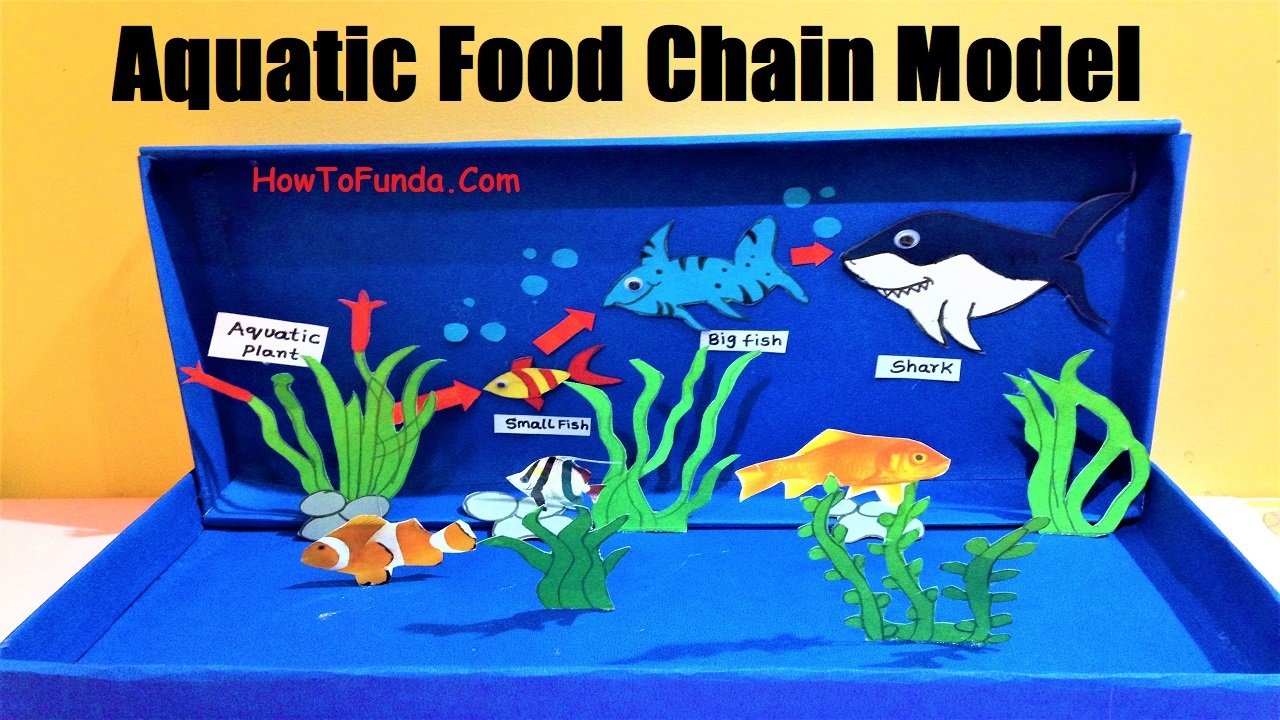INTRODUCTION
In this topic, we are going to show you how to build an Aquatic food chain model (Food Web) at home for your science project or exhibitions.
This homemade ocean food web science project is done using materials like a cardboard box, color papers and hot glue gun which is easily available at home at low cost.
Earth is also made up of Oceans, the air we breathe it’s also breeze the ocean.
The ocean part is also hosted various species of plants and animals. This entire organism in the ocean ecosystems known as ocean ecosystems.
Human-caused climate change is warming our planet, and the oceans are feeling the heat. Plants and animals in the ocean ecosystem are sensitive to changes in the ocean’s temperature. Some organisms can adapt to the change, but others can’t survive the warmer temperatures. Since so much life is dependent on these waters, it’s important to keep the oceans healthy!
What is a food web in science
Food chain involves components that help in the conversion of food energy from producers (plants) to the higher consumers (carnivorous animals) in the process of repeated eating and being eaten up.
Here one type of organism is related to another for food.
Example of Aquatic food web with explanation
Here food chain occurs in aquatic water(aquatic food web).
Small algae are a producer in the aquatic food chain and zooplankton are herbivores, small fishes are secondary consumer and large fishes are the tertiary consumers.
In the ocean, plants are in abundant phytoplankton. Here copepod might eat the phytoplankton, and a herring would come along and eat the copepod.
A seal would consume a few herring. Killer whale or orca which eats the seal.
Simple food chain examples
Here are the simple food chain examples i could list for your reference
- Insect -> fish -> humans
- Crayfish – > catfish – > humans
- Bacteria – > clams – > octopus
- Tubeworms – > crabs – > shrimp – > zoarcid fish
- Rice – > rat – > owl
- Leaves – > caterpillars – > birds – > snakes
- Leaves – > giraffes – > lions – > jackals
- Sun – > berries – > bear – > bacteria
- Sun – > grass – > ant – > echidna – > dingo
The main function of Aquatic food chain
- It helps to transfer energy and materials
- Depicts the structure of living components
How to create an aquatic food chain step by step?
In this video, we will show steps by step video instructions on how to build the aquatic food chain model at home easy way.
First take an empty rectangular box, stick blue paper inside the box. Next take green color paper and cut it to make different types of plankton.
Now use different color papers like yellow, orange, white and blue to create multiple types of fish from small to big in size.
Now stick the various planktons to the blue box at one end with the help of glue gun.
Place various fishes above the planktons, which are varying in size from small to big with directional arrows showing the consumption of small to big fishes.
Create labels that say the aquatic plant, small fish, big fish, and shark. You’ve created an aquatic food chain with a simple unidirectional arrow that helps to complete the entire aquatic food chain.
Materials Used to Make an aquatic food chain model
Materials used in this video are shown below to build an aquatic food chain model at home by taking the help of your parents.
- Scale
- Pencil
- Waste
box
- Fevicol
- Color
and white papers
- Scissor
- Hot
Glue gun
- Sketch
pen
Questions & Answers on aquatic food chain
1. What is aquatic food chain?
Various components that are involved in transfer of food energy from producers like plants to higher consumers like carnivorous animals in process of repetitive eating and being eaten up is called as aquatic food chain.
2. Why are protozoans known as an important link for aquatic food chains?
Protozoans consume and digest algae as a predator which in turn helps to decrease chances of eutriphication of the surrounding water.
3. What are the types of food chain?
Two types of food chains are: Grazing food chain and Detritous food chain.
Conclusions
Aquatic food chain model helps students to learn about the process of the food chain,
Transfer of food energy from produces to consumers and as well as how to make it with easily available materials at home.

